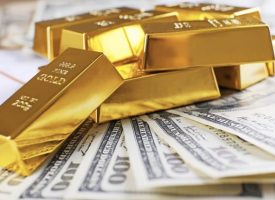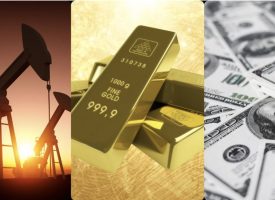Get ready for a trip down the rabbit hole of market madness and $7,000 gold.
A Crazy 2021
December 20 (King World News) – Dr. Stephen Leeb: A lot of crazy things have happened in 2021, but for gold investors, here’s one of the craziest: Gold as of mid-December is down around 7% for the year even as a broad-based index of raw commodities is up 32%. That divergence is unprecedented – the norm is that when commodities are uptrended, gold leads the way. Gold stocks, meanwhile, are down more than 25%, with some smaller miners dropping even more.
So should gold investors despair, give up the fight, abandon gold and gold-related investments? Far from it. This state of affairs won’t last. In the not-too-distant future, you’ll be seeing gains in gold and in the right gold investments that will be historic.
I base this confident assertion first and foremost on gold’s ability to serve as a currency or at least as a critical part of a monetary system and the strong likelihood – I would call it a near certainty – that we’ll see a new global gold standard introduced. Maybe China will engineer it, or maybe the markets, overwhelmed by economic fundamentals, will force the world to give up on the dollar as the world’s reserve currency. But either way, it will happen.
Gold’s Recent Behavior
It’s striking that gold’s recent behavior has gone hand in hand with strong gains in the dollar. Since late 1971, when the U.S. gave up on the gold standard, there has been a consistent and strong negative correlation between the dollar and gold. The chief reason is that gold, which central banks still consider a currency, is the most natural rival to the dollar as a reserve currency. As I pointed out in a recent interview, since 1870, during the 70 or so years in which the dollar was backed by gold, the U.S. economy experienced strong growth with low inflation. Those 70 years were a period in which the U.S. transitioned from an emerging economy to the world’s largest economy. Moreover, the latter part of that period, the 25 years after WWII, was a time when U.S. creativity was at its peak. The entire foundation for today’s information technologies and biotechnologies was laid in those years by U.S. ingenuity.
It’s hardly a surprise, then, that gold would be viewed as the most natural challenger to the dollar. Though U.S. analysts come up with a lot of reasons for U.S. dollar strength, the one most often cited is rising U.S. bond yields. More recently in the wake of the recent Fed meeting, the dollar’s strength has been credited to investor anticipation that the Fed would get “ahead of the curve” – a cliché that suggests that investors all along bought into the view that the Fed would be tightening in anticipation of inflation rather in reaction to it. Given that inflation has been accelerating at a record rate, this explanation makes as much sense as saying the U.S. has emerged as the clear leader in a race to land a spaceship on the sun.
Rising yields may seem, on the surface, a bit more plausible as an explanation in that 10-year Treasury bond yields have risen about 50 basis points since the beginning of the year, compared to European 10-year yields that have risen 20 basis points. Moreover, U.S. interest rates remain positive, while European rates are negative…
With surface samples as high as a staggering 300,000
grams of silver, this company is looking to make
one of the largest silver discoveries in history!
CLICK HERE OR IMAGE BELOW TO FIND OUT MORE.

Market Madness Continues
However, since mid-April, which is when the dollar began its steady ascent, 10-year yields have fallen by more than 15 basis points compared to less than 10 basis points for European rates. Moreover, these changes are changes in nominal rates. Real rates – nominal rates minus inflation – are a far better measure of the returns an investor gets from holding a bond. Since mid-April, U.S. inflation on an annualized basis stands at 7.8% compared to 4.3% for the euro zone. This means that U.S. interest rates currently stand at minus 6.4% compared to minus 4.4% for European rates.
In other words, to suggest the dollar’s rise is due to interest rate differentials is equivalent to saying investors would rather lose more money than lose less. Maybe that’s not as silly as the “ahead of the curve” argument, but it’s right up there.
Another bit of nonsense is how the recent Fed meeting was interpreted by the financial press. It was widely reported as Fed Chairman Powell taking a tougher stance on inflation. It’s true that he admitted that inflation was not transitory and that therefore the Fed would begin to tighten monetary policy by tapering government bond purchases. He also told investors that as of now the Fed expects to start raising Fed fund rates in 2022.
But forget about the promises for 2022 and instead look at what he actually said about current tapering. The Fed is known to choose its words carefully. And what it said was that going forward, government bond purchases would be at least $60 billion a month, down from at least $95 billion a month. In other words, the Fed plans to continue to purchase government debt without any upside limit. Keep in mind that prior to the 2008 debacle, buying government bonds as a tool of monetary policy was so aggressively loose it was never considered. Yet this is how the Fed is now responding to a multi-decade high in inflation – and supposedly helps account for why the dollar is currently so attractive while gold is a wallflower.
Is it really surprising, then, that interest rates fell in response to the Fed’s promise of higher rates in the fairly near future? No, but it is frightening. The markets either have completely lost confidence in the Fed or believe that even token gains in rates will be too much for an economy that already has monetized more than $8 trillion dollars in debt and whose current debt-to-GDP ratio far exceeds past records.
Wild Trading
To give just one example of where some of that monetized debt has gone, consider lumber prices. Lumber’s current price is about $1,100 per carload. While this is down from May’s record highs of $1,700, it is almost twice the price as recently as mid-September. It’s just one example of a massive bubble. Even in the lead-up to the housing bubble in 2007-08, lumber never reached $500. Perhaps more worrisome than lumber is the rise in home prices – which is where a lot of the lumber is used. According to the Case-Shiller Index, the 19.5% gain in home prices is the highest ever, by a wide margin.
The question then becomes why has gold’s performance over the past year – really, the past 18 months or so – been so disappointing? After all, virtually every indicator from inflation to massive money printing to the burgeoning trade deficit not just with China but with Europe as well would seem to point to gold being strong.
Ironically, it may well be that it’s gold’s longer-term potential that itself accounts for its current faltering. Why? Because, as mentioned above, gold is the most likely challenger to the dollar. A soaring gold price in combination with a collapsing dollar would be an overwhelming argument for a new reserve currency in which gold plays a major role.
And whether initiated by China or by the markets themselves, such an outcome would rob the U.S. of its major weapon in trying to manage world events. U.S. sanctions would cease to have meaning. Particularly given what some are calling a Cold War with China, this is something Western countries are desperate to avoid. So are Western financial institutions. (Though as I’ve said before, a new monetary system could be the best thing to happen to the U.S., which in numerous ways began a long-term decline once we ditched the gold standard.)…
New interview from legend Doug Casey discussing gold, silver and
global chaos! To listen click here or on the image below.

The Paper Gold Manipulation Scheme Will Fail
While I don’t tend to view events in terms of conspiracies, in this case the possibility of some form of manipulation comes to mind. Realize that the most active markets in gold are derivative paper markets, in which participants trade with enormous leverage. How leveraged? In a typical year, 10 times the amount of gold ever mined is traded on paper gold markets. This makes the paper market a much more important price setter for the metal than actual supply and demand for physical gold.
This kind of leverage means that it takes relatively little money to make a big impact on gold’s price, which makes gold relatively easy to manipulate. Manipulation of gold and other assets that trade with enormous leverage is more than just a hypothesis – J.P. Morgan was recently fined about $1 billion by federal agencies for manipulating the metal markets. I can’t prove gold is being manipulated. But a fine of $1 billion for years of manipulation is chump change for a gigantic financial institution like J.P. Morgan. Also, market manipulation is a felony, but the bank was never accused of felonious conduct. To jump from a slap-on-the-wrist fine to concluding that government agencies are involved in market manipulation is admittedly a big jump. But given how important the dollar is to this country’s status in the world, it’s not all that far-fetched. I hope I’m wrong, but I’m not dismissing the idea out of hand.
However, if J.P. Morgan and other U.S. financial institutions are pulling all the levers to hold gold down, they can’t do it forever. The game will come to an end, as I have argued before, once China takes the next steps towards a new monetary system or maybe even more likely when the markets themselves overwhelm the manipulators and the dollar crashes and burns while gold skyrockets. Keep in mind that any credible suggestion that gold will back a new reserve currency would be a catalyst that could send gold soaring overnight as manipulators are forced to cover short sales. Such a suggestion could come if China’s digital currency, due to be introduced in February, enjoys better-than-expected success.
Currently, the only real pushback against gold dropping too much – and perhaps strong evidence that its price is being manipulated – came on a Sunday evening, when normally the gold market is barely trading. A massive sell order sent gold on a stomach-churning fall. Some entity, or the public at large, was willing to buy aggressively to break the fall. For the moment this interest in gold is asymmetric in that whoever is willing to support the metal is not yet willing to buy aggressively enough to push the metal higher. That will end with a massive bang – it is just a question of when.
For gold investors, this is the time to get extremely aggressive, because your downside is limited, likely to the area where buying appeared when massive, unexpected selling occurred – somewhere near $1,680. At the same time your upside is as close to limitless as has ever been true for any major asset…
ALERT:
Billionaire and mining legend Ross Beaty, Chairman of Pan American Silver, just spoke about what he expects to see in the gold and silver markets and also shared one of his top stock picks in the mining sector CLICK HERE OR ON THE IMAGE BELOW TO HEAR BEATY’S INTERVIEW.

$7,000 Gold
One way to get a concrete handle on how high gold could go is to look at changes in world GDP since Bretton Woods. Population growth plus real economic growth plus inflation suggest that nominal world GDP has multiplied by 200 times. That number alone points to gold at about $7,000 (200 times $35, gold’s fixing at the time of Bretton Woods). And that’s likely just an initial target, since it does not consider the massive build-up in world debt. Any solution to the debt issue will likely multiply gold’s initial target price of $7,000 by several times.
Moreover, similar to what occurred with Bretton Woods, it could take a decade or more from the first discussions about a new gold standard and its full implementation. During that time the world will hopefully experience decent nominal growth – especially if some preliminary rules for a new monetary system are put into place. At the point of full implementation of a new monetary system with gold at its center, gold’s price is likely to be at least several times the initial target. Those would be gargantuan gains from today’s level.
To sum up: Whether the U.S. and the West resist it or ultimately cooperate on a new monetary standard, gold is headed far, far higher. If you haven’t yet bought gold or gold-related investments, or if you want to increase your exposure, you couldn’t ask for better timing. Your downside is likely less than 10%, while your upside is likely higher than you ever had imagined.
***ALSO JUST RELEASED: Greyerz – The World Has Now Entered The First Of Four Major Phases Of Chaos And Financial Destruction CLICK HERE.
***ALSO JUST RELEASED: CALL IT A COMEBACK: Mining Stocks Have Soared Every Time After This Signal! Returns Averaged 25% In 3 Months But Look At Longer Term Gains! CLICK HERE.
To listen to Stephen Leeb’s forecasts and surprises to expect for 2022 as well as what to expect in the gold market CLICK HERE OR ON THE IMAGE BELOW.
To hear Alasdair Macleod discuss the long delays for large orders from refiners of physical gold and silver CLICK HERE OR ON THE IMAGE BELOW.
© 2021 by King World News®. All Rights Reserved. This material may not be published, broadcast, rewritten, or redistributed. However, linking directly to the articles is permitted and encouraged.









